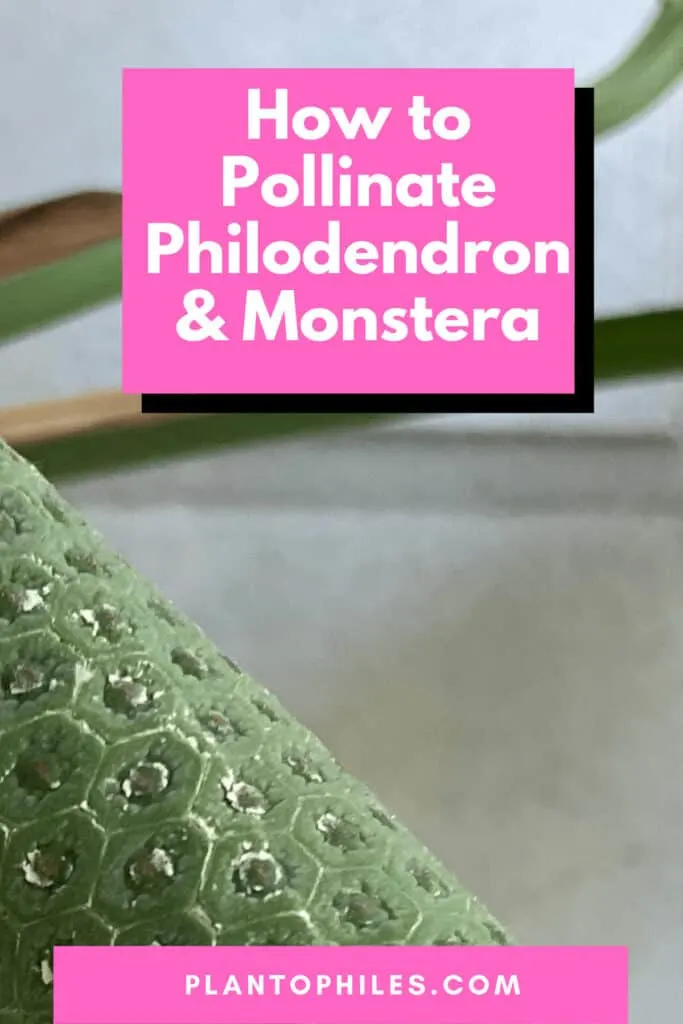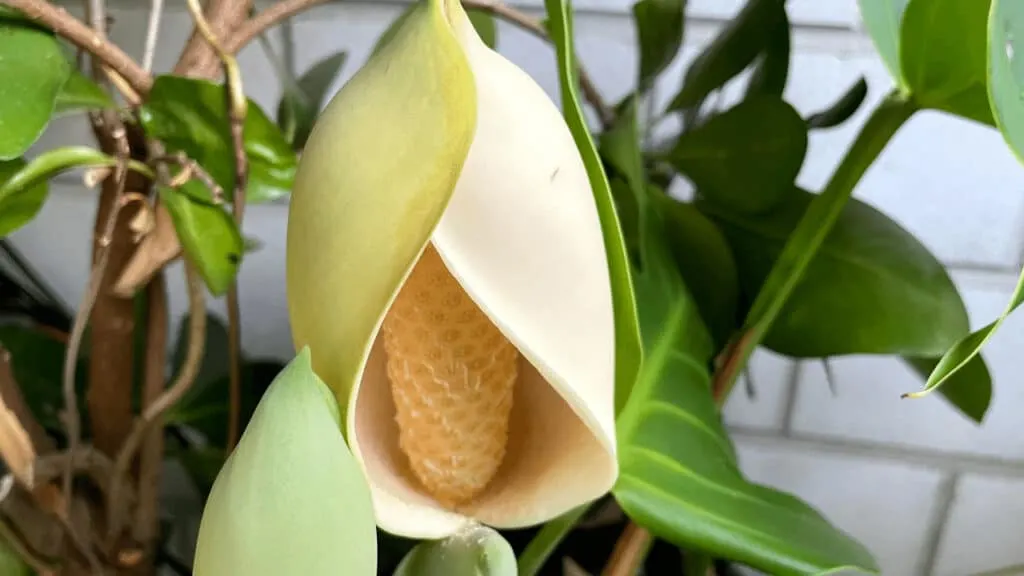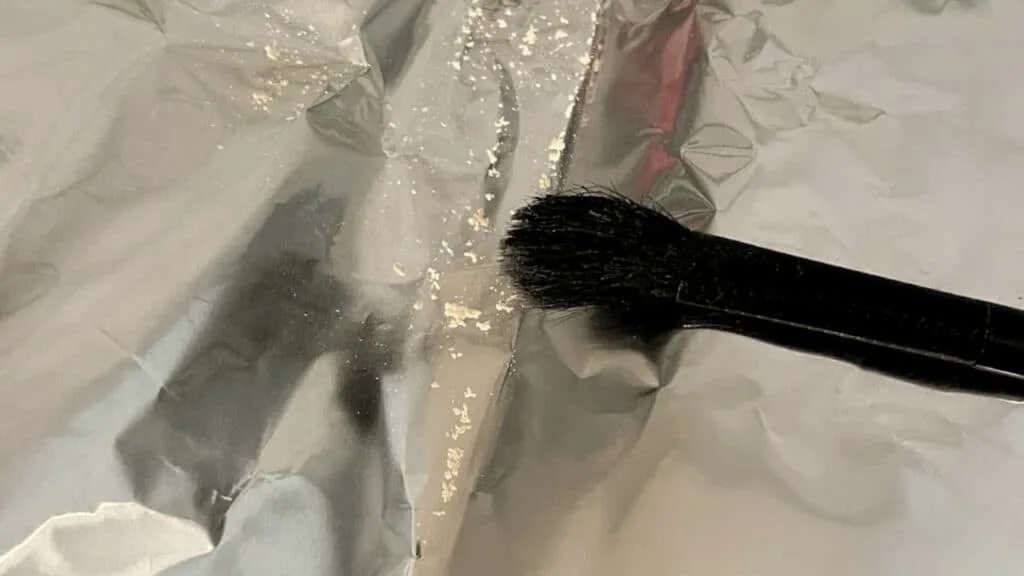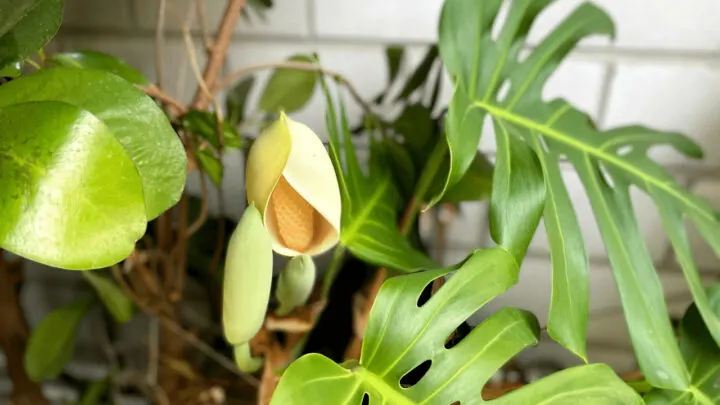Self-pollination…cross-pollination…pollination by hand. Sounds a little technical? Not necessarily.
If you think about a plant needing magic dust to help it procreate, then it’s a little simpler. That dust can either be supplied from the same plant or another.
That’s easy to understand, I would think. It’s when you’re expected to spread the magic dust yourself that it sounds a little complicated.
Again, though, not necessarily.
Table of Contents
How to Pollinate Philodendron and Monstera
Philodendrons have male and female flower parts to their flowers, but the cycles do not coincide. Hence, the plant is unable to self-pollinate. Monstera has both male and female flowers and can self-pollinate. Sometimes, it is necessary to pollinate by hand, which you can use on both Philodendron and Monstera.

Pollinating your Philodendron or Monstera
Pollinating your Philodendron or Monstera is quite simply taking the pollen coming from the stamen of the first plant or flower and then rubbing it onto the relevant stamens.
In a Philodendron, this needs to be a different plant or a separate flower of the same plant. In a Monstera, this will be the female flower of the same plant.

When to Pollinate
You will need to pollinate your plant during the female cycle. In both Philodendron and Monstera, this is indicated by the spathe getting hotter and a scent being released.
In the Philodendron, the temperature is higher than in the Monstera.
When it is hot enough, the spadix of the plant will open. This usually lasts for about 48 hours.
It is fertile during these two days, and pollination must take place. It’s best to perform this during nighttime.
Harvesting Pollen
To pollinate your plant, you first need to collect pollen, which is relatively easy as long as you do it when the male parts of the plant have produced the pollen.
In a Philodendron, this is about two days after the female part is fertile. In Monstera, the male cycle begins after the female cycle, but the two overlap.
Take the spadix and hold a tissue, a piece of fabric, or a flat glass container just below it. Shake the spadix gently so the pollen will fall off onto the cloth or container.

Using the Pollen
To pollinate Monstera, apply the pollen to the stamens of the same flower. With a Philodendron, you’ll need to keep the pollen until there is a second flower on your plant by putting it into an air-tight container in the deep freeze.
When the second flower is fertile, remove the pollen from the deep freeze, leave it for an hour, and then use it to pollinate the flower.
Using the pollen immediately after harvesting is possible if you have a second Philodendron plant.
Applying the Pollen
To fertilize your plant, you must simulate the natural process and pollinate by hand.
To do so, take a soft brush and gently pick up some pollen from the cloth or container.
Brush this gently onto the plant’s pistils, which will think that this is simply the natural agent bringing pollen and pollination should occur.
Understanding Pollination
When a plant is pollinated, the pollen moves from the stamen to the pistil, which are the plant’s male and female parts, respectively.
The plant cannot do this independently – an agent, such as a bee, needs to be involved.
The stamen’s pollen sticks to the bee’s legs in the flower. As it moves to the female part of the flower, the pollen rubs off onto the pistils, pollinating the plant.
When this is done between flowers of the same plant, it’s self-pollination.
If a plant has a unisex flower with a male and a female part, then the pollen never reaches the female part when it is fertile. This means that the plant cannot self-pollinate.
It also means another is needed so that the pollen from that can fertilize the pistils of the first plant.
Pollinating Philodendron
In a Philodendron, male and female parts are in one flower, and the plants are not designed to self-pollinate. This is achieved by the male and female parts not being active simultaneously.
The plant’s pistillate section (female) portion will begin its cycle and open for pollination a full 48 hours before the male part is active – and closes before the male cycle begins.
In the wild, a scarab beetle gathers the pollen from plant one on its body. It then moves through some other plants.
Because not all the plants will be on the same ‘cycle’, the pollen of plant 1 can be rubbed onto the pistillate forms in plant 2, or plant 3 – so the plants are cross-pollinated.
A Philodendron plant can be pollinated from its pollen, but only if there are two separate flowers on the plant – and Philodendron only produces one flower at a time.
This is where you come in: you will need to take a hand in pollinating your Philodendron if you want it to procreate.
Pollination in Monstera
Monstera plants have male and female flowers, meaning they can self-pollinate.
This does depend on the male and female cycles overlapping. This doesn’t occur in some plants, so self-pollination is not successful. The alternative is for you to pollinate your Monstera by hand.
What is useful with pollinating a Monstera, is that the pollen from one plant can be used to pollinate the same plant because the male and female flowers are separate.
The Swiss Cheese plant spadix will turn into the Monstera deliciosa fruit, which is edible.
Frequently Asked Questions about How to Pollinate Philodendron and Monstera
Will my Philodendron pollinate itself?
In their natural habitat in the tropics, Philodendrons are pollinated by a beetle, which moves between plants. However, the beetle does not exist outside this region, so pollination is theoretically impossible. That is unless the Philodendron are pollinated by hand.
Conclusion
Self-pollinate: this is what Monstera can do. Cross-pollinate: this is what Philodendron need.
Pollination by hand: this is what you can do to help your Philodendron to flower.
Not so complicated after all, are they?

Daniel has been a plant enthusiast for over 20 years. He owns hundreds of houseplants and prepares for the chili growing seasons yearly with great anticipation. His favorite plants are plant species in the Araceae family, such as Monstera, Philodendron, and Anthurium. He also loves gardening and is growing hot peppers, tomatoes, and many more vegetables.


